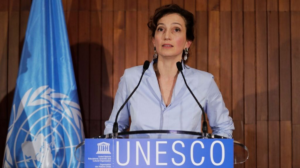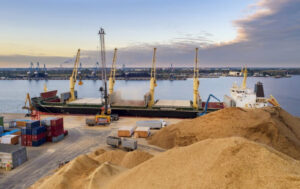
II Scientific and Practical Conference “Green Construction” will bring together leading experts and business representatives in the field of environmentally friendly construction
On April 13-14, 2023, the II Scientific and Practical Conference “Green Construction” will be held.

The event will bring together representatives of government agencies, education and science, NGOs, business, top managers, leading experts, journalists and stakeholders in the field of energy-efficient and environmentally friendly green construction.
The event will be held in a mixed mode, participation is free of charge.
Conference materials along with the application form (attachment) should be sent by e-mail to kaflab241ecolog@gmail.com.
The Organizing Committee reserves the right to refuse to publish materials that do not meet the requirements for formatting or are of an abstract nature, as well as to make minor edits to the received materials. Authors receive an electronic version of the conference materials.
Partners:
Kyiv Regional Council; Subcommittee on Urban Development, Improvement and Land Relations within the Development Area of the Committee of the Verkhovna Rada of Ukraine on Organization of State Power, Local Self-Government, Regional Development and Urban Planning; State Enterprise “Research, Design and Technological Institute of Municipal Economy”; Odesa State Environmental University; Lviv Polytechnic National University; Taras Shevchenko National University of Kyiv; National University “Yuri Kondratyuk Poltava Polytechnic”; Yuriy Potebnya Engineering Education and Research Institute of Zaporizhzhia National University; Donbas National Academy of Civil Engineering and Architecture (Kramatorsk); Academy of Construction of Ukraine; Academy of Technical Sciences of Ukraine; Art Studio 22 ART HUB; National Union of Journalists of Ukraine;
International Technology Transfer Association (ITTA); The Agency for the Reconstruction of Ukraine; Czestochowa University of Technology; Azerbaijan University of Architecture and Construction; Georgian Technical University; Experts Club.
The time limit for a presentation is 7-10 minutes.
Contact phone numbers of the conference organizing committee:
Olena Zhukova +38(096)8752104, +38(063)8136063;
Tkachenko Tatiana Mykolaivna +38(067)353-38-77, +38(066)529-91-36
Open4business is a media partner

Global stainless steel production in 2022 decreased by 5.2% y-o-y to 55.255 million tons, with production decreased in all major regions, according to a press release from The world stainless association (formerly International Stainless Steel Forum – International Stainless Steel Forum, ISSF).
According to the information, stainless steel production in Europe in 2022 decreased by 12.4% to 6.294 million tons in 20221, in USA – 14.8% to 2.017 million tons.
In Asia (excluding China and South Korea), stainless steel production decreased by 4.9% to 7.411 million tons, while in China it decreased by 2% to 31.975 million tons.
Other regions (Brazil, Russia, South Africa, South Korea and Indonesia) recorded a 9.1% drop in production to 7.557 million tons.
As it was informed the world volume of stainless steel production in 2021 increased by 10,6% in comparison with the previous year, up to 56,289 mln tons. Meanwhile, in Europe, stainless steel production for 2021 increased 13.6% to 7.181 million tons from 2020, and in the U.S. it increased 10.4% to 2.368 million tons. In Asia (excluding China and South Korea), stainless steel production rose 21.2% to 7.792 million tons, while China increased production by 1.6% to 30.632 million tons.
Other regions (Brazil, Russia, South Africa, South Korea and Indonesia) recorded a 42% increase in production, to 8.316 million tons.

Primary new passenger cars in March this year increased by 21% compared to February this year – up to 4,511 units, said “Ukravtoprom” in Telegram-channel.
The Association says that the demand for passenger cars increased 8 times compared with March of the last year, but only because of the low comparison base (March 2022 was the first month of full-scale invasion of Russia into Ukraine – IF-U).
Toyota remains the leader of registrations – 648 units, second place again belongs to Renault with 438 cars (in February the brand was 5th), third place – to Volkswagen with registrations of 432 cars.
Fourth place went to BMW with 355 cars, and Skoda was at the bottom of the list in March with 346 cars.
Bestseller of the first month of spring in the Ukrainian market of new passenger cars was the crossover Renault Duster, which was chosen by 414 buyers.
At the same time more than a third of March market was formed by 10 popular models – Renault Duster is followed by Hyundai Tucson (171 units), then Mazda CX5 (171), Volkswagen ID.4 (149), Toyota RAV-4 (131), Toyota Camry (110), Suzuki Vitara (105), Volkswagen Touareg (101), DongFeng/Honda M-NV (100) and BMW X7 (99 units).
In total, 11.2 thousand new cars were registered in Ukraine in the first quarter, which is almost as much as in the past, states Ukravtoprom.

Western European stock indices were mostly on the rise on Monday thanks to a surge in shares of oil producers, which reacted to a jump in oil prices.
The Stoxx Europe 600 composite index of the largest companies in the region rose 0.1 percent to 458.31 points by 11:25 a.m.
The British FTSE 100 stock index was up 0.7%, the German DAX – less than 0.1%, the French CAC 40 – 0.3% and the Italian FTSE MIB – 0.4%. Meanwhile, Spain’s IBEX 35 lost 0.3%.
Oil rose more than 5% in trading after 8 out of 20 OPEC+ countries announced a voluntary reduction of oil production from May until the end of the year.
On the news, securities of leading oil industry players jumped in price, including BP Plc (4.4%), TotalEnergies (4.1%) and Shell (4%).
Meanwhile, on Monday it became known that the Purchasing Managers’ Index (PMI) in the euro area processing industry in March fell to 47.3 points from 48.5 points in February, renewing the lowest in four months. Preliminary data from S&P Global, which calculates the indicator, pointed to a drop to 47.1 points.
In Germany, industrial PMI slid to 44.7 points from 46.3 points, in France to 47.3 from 47.4 points and in Italy to 51.1 from 52 points. Meanwhile, in Spain, the indicator rose to 51.3 from 50.7 points.
Shares of UBS Group AG jumped by 4.1% on rumors that the Swiss bank was preparing to lay off 20-30% of its employees amid a merger with rival Credit Suisse. According to the sources of the newspaper SonntagsZeitung, the reduction could affect 25-36 thousand employees of the total staff of the bank, which after the merger will be about 120 thousand people.
The capitalization of the cinema chain Cineworld Group plummeted by 22.5% after the company stopped selling its assets in the United States, Britain and Ireland.
The price of Italian oilfield services company Saipem jumped by 5.5%, industrial Tenaris – by 4.2%, energy company Eni – by 3.9%.
Quotes of French banks BNP Paribas, Societe Generale and Credit Agricole grew by 1.1-1.7%.
The market value of Airbus increased by 1.3% and updated its maximum in five weeks.

UNESCO Director General Audrey Azoulay has arrived in Ukraine, First Deputy Foreign Minister of Ukraine Emine Japarova said.
“As the head of the National Commission of Ukraine for UNESCO, I am honored to welcome Audrey Azoulay to Kiev. The visit of the UNESCO Director General is a huge sign of support for our efforts to protect and restore culture, education, science, youth, sports and media in Ukraine. These issues are on the agenda today,” she wrote on Twitter.

Ukraine exported 3.8 million tonnes of agricultural products under the grain deal in March, 500,000 tonnes more than in February, the Agrarian Policy Ministry of Ukraine reported on March 31.
This included 908,000 tonnes of wheat and 2.3 million tonnes of corn.
The ministry said 374,000 tonnes of wheat, 120,000 tonnes more than in February, was shipped to countries in need, including 60,000 tonnes shipped to Yemen and Ethiopia under humanitarian programs.
At the same time, the Ministry of Agrarian Policy said that over the past three months of the functioning of the corridor, the number of vessels passing the Bosphorus has been steadily fluctuating in the range of less than 3 instead of 6-7 possible, and the worst figure was in January – 2.5.
“Today is the end of the 8th month of the grain corridor. The indicators for March differ little from February. In particular, the statistics of the number of ships passing per day have not changed for the better. We have an indicator of 2.8,” the ministry said.
A total of 26.3 million tonnes of Ukrainian agricultural products, including 7.3 million tonnes of wheat and 12.9 million tonnes of corn have been exported in the eight months since the agreement on the grain corridor for Ukrainian exports was struck, the ministry said. Almost 2 million tonnes or 26.4% of this wheat was shipped to countries in need, it added.
“However, there are countries where the supply of our grain has dipped due to the unpredictability of the functioning of the corridor and the unwillingness of buyers to take risks. Among them is Indonesia. If before the war we sent 2.6 million tonnes of wheat there, which was 24% of their annual needs of 11 million tonnes , then only 341,000 tonnes went there during the last marketing season, which is only 4%,” the Ministry of Agrarian Policy said.
The UN, Russia, Turkey and Ukraine signed two documents in Istanbul on July 22, 2022 on the creation of a corridor to ship out grain from three Ukrainian ports – Chornomorsk, Odesa and Pivdenny, as well as to lift barriers to exports of Russian foodstuffs and fertilizers. The arrangement was extended for 120 days in November 2022, and in March 2023 Russia agreed to another extension of 60 days.